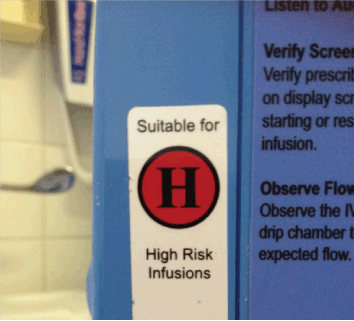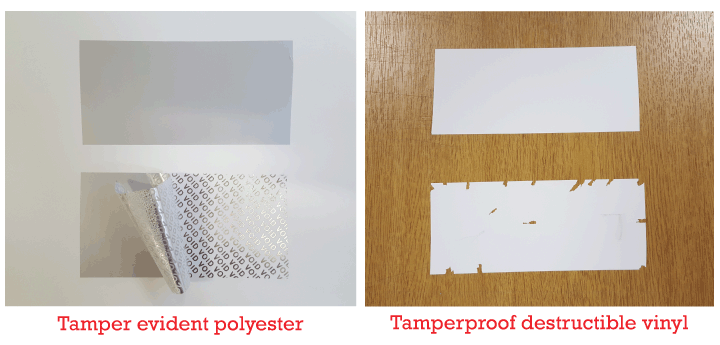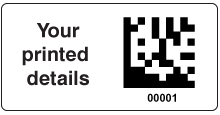Many of our labels are supplied for marking enclosures or cabinets housing control or automation equipment for industrial, electrical, traffic control, street lighting, security or telecommunications purposes. These custom produced labels include branding of company logos, rating plates to identify make and model, operating instructions, asset or inventory control, or for safety (such as electrical voltage symbols).
The cabinets or junction boxes can be for indoor or outdoor use and the specification of such labels should reflect the differing applications.
Adhesives have to be chosen to suit the enclosure fabric, which can vary from plastics, fibreglass to metal (such as aluminium, galvanized stainless steel). Also, surface finishes can vary from low energy, to stippled or contoured. Another option is to provide metal labels with drill holes for screwing or riveting to housings.
Operating conditions can vary from clean hygiene environments, where surfaces need to be regularly be treated for contaminants), to marine conditions with high salt or chlorine content, harsh climatic conditions (high precipitation, high winds, dry dust, UV resistance, or low/high temperatures), or aggressive chemical atmospheres. Therefore, the choice of materials and protective laminates can be critical to enable the labels to suit the application.
So, no matter if these are free standing, or wall mounted, for internal or external location, we can work with you to provide a labelling marker solution. To discuss your label needs contact us by e-mail sales@labelsource.co.uk or call us on 0800 3761693 (Freephone in the UK), or + 44 (0) 1443 842769 (outside UK).
For many years, Label Source has supplied a diverse selection of labels, signs and tags for healthcare equipment and devices for medical, bioscience and clinical applications.
They include labels for function, safety and electrical (PAT) testing, calibration, validation, and asset management. Many are used for preventive maintenance, and servicing to provide safe and effective utilisation of healthcare patient monitoring equipment, including; infusion pumps; dialysis machines; x-ray equipment; PACS (MRI, CT scanners, ultrasound etc.); blood pressure monitors; ECG machines; capnography products; spirometers; pulse oximeters; cardiac and vital sign monitors; defibrillators; microscopes; powered wheelchairs; and treadmills.

Customers include NHS hospitals, private hospitals, care homes, dental practices, GP surgeries, clinics, laboratories and clinical research facilities for applications including monitoring, diagnostic and therapy equipment for medical electronics and electrical engineering or biomedical engineering.
Some of these labels include standard label ranges such as write and seal labels and calibration labels. Others are designed to customer specification and comply with user applications, and can combine a diverse range of information including customer details, contact information, use and safety instructions, and in the case of inventory management incorporating serial numbers or barcodes. Labels can be created to provide scratch and chemical (swab) resistant, and adhesion on many surfaces including low energy plastics and stippled finishes.
For further information contact us by e-mail at sales@labelsource.co.uk or by telephone using 0800 3761693 (Freephone) or +44 (0) 1443 842769.
There are two main forms of labelling where security and product integrity are key application features. The label options tend to be destructible vinyl, often called tamperproof, which fragment on attempted removal, and tamper evident polyesters, where a pattern (void, checkerboard, chainlink etc.) remains if labels are removed.
Destructible vinyl labels have a combination of low tensile strength and high tack pressure sensitive adhesive. If the label is tampered with it will break up into small fragments, thus preventing the label being removed intact and able to be transferred to another object. The adhesive is suitable for use on a variety of surfaces including contoured, lightly textured, powder coated or low energy.
On any visual inspection it is evident that there has been an attempted breach of the product integrity. Therefore this material lends itself suitable for applications covering warranty, service or calibration seals, asset labels and asset tags (including serial numbering, or barcodes) and safety instruction labels. The labels can be manufactured to include company logos, and bespoke details as well as the fore mentioned barcode or number identification.

Tamper evident labels can be used for similar security applications, where the label will divide into a pattern within the material which will remain on the object surface, while the non-patterned section can be removed. Therefore, once again this type of label cannot be removed intact and replaced elsewhere. These self adhesive polyester materials are available with a selection of patterns including the more popular void and checkerboard. Again these can be used for asset labels, asset tags and product integrity and security purposes. The added advantage of custom printed labels using tamper evident polyester is that they can be laminated with a clear laminate to provide extra chemical, UV (ultraviolet) and abrasion resistance.
These labels or markers are used in manufacturing, retail, distribution and commercial sectors. Some of our standard ranges include asset tags and serial number labels, barcode labels, tamperproof calibration labels and tamper evident calibration labels.
Labels can be produced to customer specification in an extensive range of shapes and sizes. For a quotation to produce the most suitable product to meet your needs, contact us on e-mail sales@labelsource.co.uk or by telephone freephone 0800 3761693 or +44 (0) 1443 842769.
There has been a rapid growth in the use of QR two dimensional barcodes, which are small in size yet are able to contain high data storage capacity. In appearance the QR (or Quick Response) codes are square dots arranged in a square grid, and can be incorporated in label designs.

These QR barcode labels can be used in manufacturing, distribution and warehousing to provide item identification, product or service tracking, and stock control. The QR barcodes labels can be produced on a range of materials including self adhesive vinyl (standard and tamperproof destructible, polyester (including tamper evident), aluminium foil, polypropylene and aluminium.
These labels can be produced to customer specification inclusive of these QR barcodes, to suit a range of operating conditions and environments. For further information contact sales@labelsource.co.uk or telephone Freephone 0800 3761693 or 01443 842769.
Our range of safety barrier tapes are not only used by the more obvious emergency services, namely police forces and fire services, but also we cater for more specialist requirements such as cave or mine rescue, bomb disposal, removal of hazardous materials, and civil emergency response planning.
These high visibility, premium quality, lightweight barrier tapes are ideal for cordoning off areas to prevent unauthorised access by alerting the public to incident sites, or to inform them of potential hazards. These non-adhesive tapes are supplied in a dispenser carton for ease of use, and are supplied in reels of 75mm by 250 metres. The printed surface is scratch and UV resistant.
So whether it stems from law enforcement services, including specialist police services (Military, RAF, harbour etc.) in isolating crime scenes or identifying crowd control routes; fire brigades and other fire services for marking fire scenes and safe routes to firefighters, other emergency services, site investigators or the general public; security: or disaster response from radiation or chemical spillage; Label Source has a range of safety barricade tapes fit for purpose.